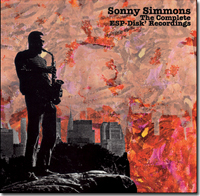|
|
 |

|
 |
Dusted Features
ESP endures and improves thanks to the merits of four recent reissues, and Derek Taylor's overview.
|
|
|
 |
Lectures in Esperanto
ESP-Disk’s re-launch earlier this year raised a lot of eyebrows. Some arched in expectation, others curved with a fair share of skeptical chagrin. As label’s original owner and producer Bernard Stollman’s reputation has weathered a lot of invective. At the very least, his decision to return to the game deserves recognition for ambition and gumption. Plenty of back-story on the label’s history and catalog is readily available via a few keystrokes, so particulars need not receive rehashing here. The resurgence continues with a handful of new reissues, repackaged with new graphics and supplemental material. Each of the four titles in this survey improves appreciably on past editions. Niggling questions over royalty payments remain, but Stollman and his employees are moving full speed ahead with projects that include a Patty Waters package and another highly anticipated Albert Ayler box. But that’s copy for a future feature, back to the present boon.

In late 1966 Sun Ra put out the cosmic call to Arkestra operatives. Assembling the necessary troops he struck out on the road with an eleven-piece band as part of an ESP package tour that also included label headliners Patty Waters and Burton Greene among others. Nothing Is represents the lone commercially released audio souvenir from that junket. After an opening piano preface by Ra the oddly-eponymous opener “Sun Ra and His Band From Outer Space” strays from space chant territory, moving through raucous solos by Marshall Allen and a bowed Ronnie Boykins to a closing Clavoline/piano coda bolstered by percolating log drum and cymbal accompaniment. “The Shadow World” undergoes a similar transformation from piano and horns driven vamp to busy percussion panoply and back again. Ra’s space chants and call/response sermons receive places in the program too. Rendered in extreme miniature tracks like “Next Stop Mars” and “Imagination”, serve as little more than fleeting signal flares for the band to switch gears. The school play-style naiveté of the sci-fi, sing-song lyrics juxtaposes beautifully with riotous horn explosions as on the quixotically low-budget “Theme of the Stargazers.”
“Outer Spaceways Incorporated” bounces along on a jaunty beat built from string bass and log drum. A show-stopper comes with “Dancing Shadows” and an R&B tinged honk-fest of a solo by John Gilmore that jockeys the frothing rhythms of the piece with practiced abandon. “Exotic Forest” maps regions even more shrouded in ersatz mystery with Allen’s muezzin oboe out front as safari guide as the rest of band playing the part of lugubrious percussion-heavy pack-beast. In line with the new ESP credo of adding unshelved material, the album concludes with nearly twenty-five minutes of newly reconstituted material including a ripping reading of the Fifties Arkestral staple “Velvet” that hinges on Pat Patrick’s blackstrap baritone and version of “Outer Nothingness” that occupies over a quarter of an hour and features some killer altissimo work by Gilmore and a martial press roll barrage by drummer Clifford Jarvis. An indisputable improvement over its earlier incarnations both in terms of fidelity and value, the sequencing of the set also gives it a more cohesive album feel.

During its early years, ESP had several momentous debuts to its name and the Reverend Frank Wright’s certainly resides near the top. The Complete ESP-Disk Recordings sensibly collects both of the saxophonist’s albums for the label under a double-disc umbrella. A series of vintage “interview” snippets featuring Wright, ESP-owner Bernard Stollman and vibraphonist Khan Jamal pad the package with engaging, but hardly essential anecdotes. Wright’s self-titled first record is terse, even by vinyl standards, with just three tracks monopolizing the A and B sides. “The Earth” starts slow and deliberate, but quickly erupts in bursts of overblowing tenor tempered by the Wright’s ghostly vocal moans. Drummer Tom Price’s earnest sticking raises a conspicuous clue as to why his name is absent from most history books, but Henry Grimes offers one brilliant turn after another, punishing his strings with strenuous plucks that exploit the full tonal girth of his bull fiddle. “Jerry” traffics in curdled R&B as Wright excoriates and blusters with a deluge of steam-heated honks atop a throbbing walking bass line and Price grapples away gracelessly with his kit. As Yang to the opening Yin “The Moon” finds the three once again targeting a non-terrestrial course through stratospheric squeals that pierce like aural bee stings, blurred bass strums and violent riptide drums. The roots of fellow fire breathers like Charles Gayle (who reportedly recorded a long-since lost tape for ESP toward the end of its initial run) and Glenn Spearman are tangled throughout these three cathartic blowouts.
Cut roughly sixteen months later in the spring of ’67 Your Prayer improves markedly on the already influential template set by its predecessor. Muhammad Ali (brother of Coltrane’s late period drummer Rashied) supplies the rhythmic blasting caps and Steve Tintweiss, soon to be sideman to Albert Ayler, handles bass. The other ensemble changes arise in the addition of altoist Arthur Jones and French trumpet specialist Jacques Coursil. Working off loose charts with plenty of room built in for sky high blowing the five deliver one of the earlier examples of finely-tuned and structured free jazz. “Train Stop” finds the leader and Ali approximating the racing wheels and shrill whistle of a cross-country locomotive. The closing energy-suffused polyphony of “Fire of Spirits” and epic episodic title track stand as lengthy brimstone-sooted classics of the idiom. Throughout Wright and Jones hit upon a superhero/sidekick relationship that the tenorman would exploit even more fully in the company of Noah Howard.

The frustrations that so frequently follow a musician who devotes his or her energies to a vocation in creative music are corollaries that speak to the marginalized state of the art form. Saxophonist Sonny Simmons has reluctantly paid these dues, scuffling and scraping for monetary and critical recompense during his four plus decades in the game. He’s a survivor to be sure, but the stress has left lasting blemishes on his spirits and a sizeable chip sitting on his shoulder. The Complete ESP-Disk Recordings documents his first two recordings as a leader. As with the identically-titled Wright reissue, interview snippets pad the two-disc set’s running times. A more contemporary conversation between the saxophonist and Minneapolis musicologist Clifford Allen contained in the liners further fills in the blanks on Simmons’ history and the hardships he faced in the years since the seminal sessions. Both dates find him in the frontline company of then-wife trumpeter Barbara Donald. Her contributions are frequently just as indispensable as his with a sharp brassy attack and daunting chops that rival nearly all of her contemporaneous peers playing in the freebop style that was Simmons’ preference. The dismay surrounding the reality that she never found a steady recording outlet on par with her husband’s is one of the set’s revelatory elements.
Simmons’ own improvisatory skills are substantial. His sharp, brooding approach to alto frequently sets land speed records in terms of velocity and register-vaulting tonal esprit. Both Staying on the Watch and Music of the Spheres feature the couple backed by a traditional (at least in an instrumental sense) rhythm section comprised of piano, bass and drums. John Hicks, who handles the ivories on the first date, demonstrates an edge over his counterpart Michael Cohen on the second, but both teams offer able and enthusiastic support to the spousal tandem. The latter session also adds the welcome presence of Pacific Northwest phenom Bert Wilson on tenor for an even more formidable phalanx of horns. Simmons’ tunes emphasize animated improvisation working off punchy boppish heads and never descending into formless free-for-all aggression. The pieces all show a strong commonality with the works of Dolphy and Coleman, though Simmons’ insists both on tape and in print that his compositional style arose without a significant debt to either. Whatever the case, these early sides stand secure as some of the finest music of the saxophonist’s hardscrabble career.

Another among ESP’s celebrated stable of signees, alto saxophonist Marion Brown also waxed a pair of dates as a leader for the label. Where Simmons favored blistering acceleration and tightly-packed streams of notes in his aggressive approach to solos, Brown accessed the also from a different, more ruminative and consistently lyrical point of ingress. As a veteran of Coltrane’s turning point Ascension session for Impulse his credentials as an energy player were ironclad. But Brown opted for a decidedly more compositional approach on his own albums. His self-titled ESP debut makes use of a crackerjack pool of players. Trumpeter Alan Shorter and tenor saxophonist Bennie Maupin (on one number) complete the horn roster while a rhythm section Ronnie Boykins and Reggie Johnson on basses and Rashied Ali on drums rounds out the ensemble. The calypso-flavored “Capricorn Moon” works off a lilting tropical vamp, stringing together a series of spirited solos from each of the musicians and relying confidently on the elastic, invigorating interplay between the bassists. Brown’s improvisation weaves a pervading blues feeling to the Caribbean source material veering from Shorter sticks mainly to flurried sprays of notes, but his minimalist style works effectively against the constant thrum and patter of the basses and drums.
“27 Cooper Square” is a fraction of the length and a tumbling Ornettish scrap with Johnson handling bass and Brown and Shorter trading jousting solos. Maupin and both bassist’s join in on “Exhibition” swelling the band to sextet size for a trip through the discursive piece. Built around another succession of episodic solos it with a flurried, pinched register turn from the leader and segues into a brick-by-brick workout from Maupin’s athletic and expressive tenor. The new also reissue includes a quartet rendering of Shorter’s dark masterstroke “Mephistopheles” with Boykins in the bass slot. The composition had its genesis under the aegis of an all-star octet on brother Wayne’s The All-Seeing Eye for Blue Note. The version here incorporates only half the manpower, but manages to annex twice the temporal space while simultaneously sustaining a heightened level of urgency and menace for much of the duration. Subsequent releases of the Brown album featured it under the name “Exhibition.” The new ESP reissue corrects the confusion by including both tracks under their proper titles. As with the Simmons and Wright reissues, Brown’s entry in the batch posits another uncommonly accomplished debut, a precedent that the altoist would build substantially upon with subsequent albums for labels like Impulse, Sweet Earth and Birth.
By Derek Taylor
|







